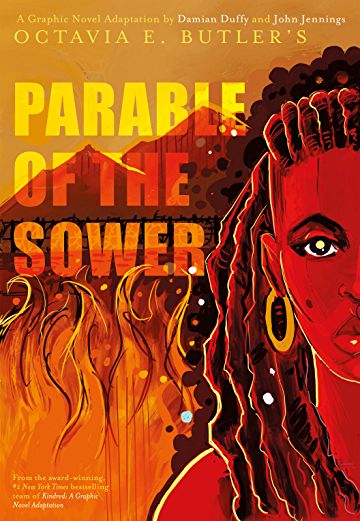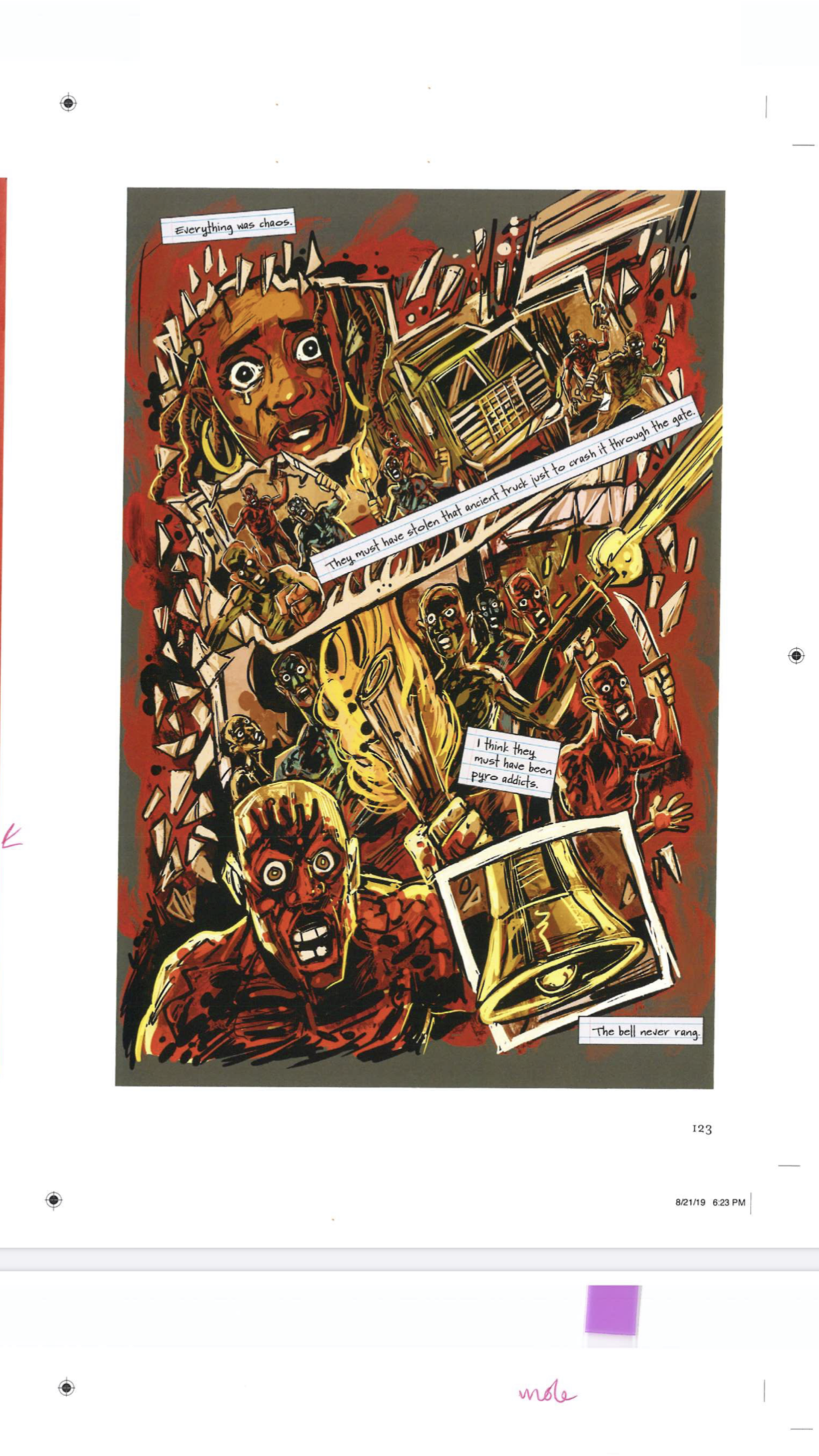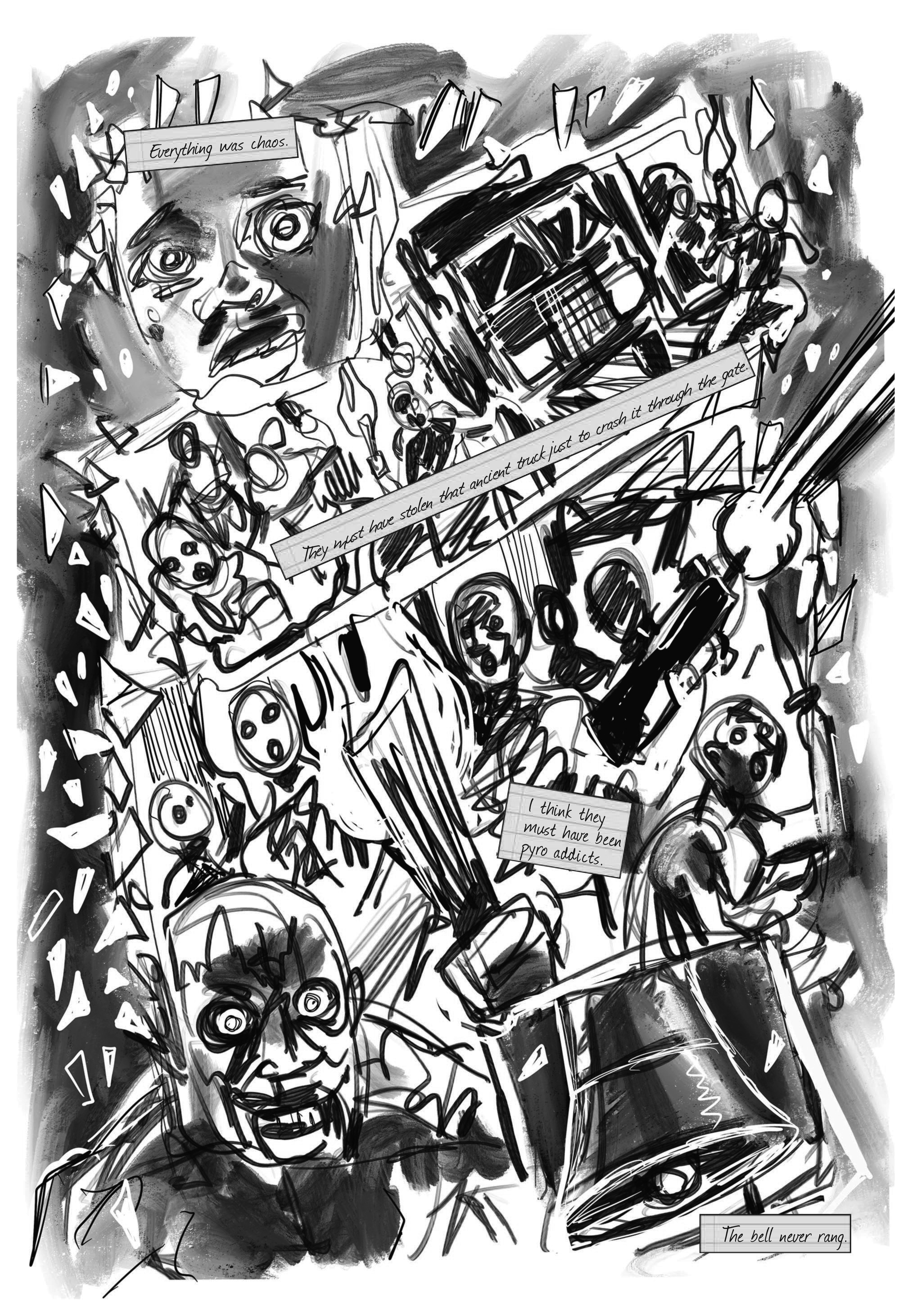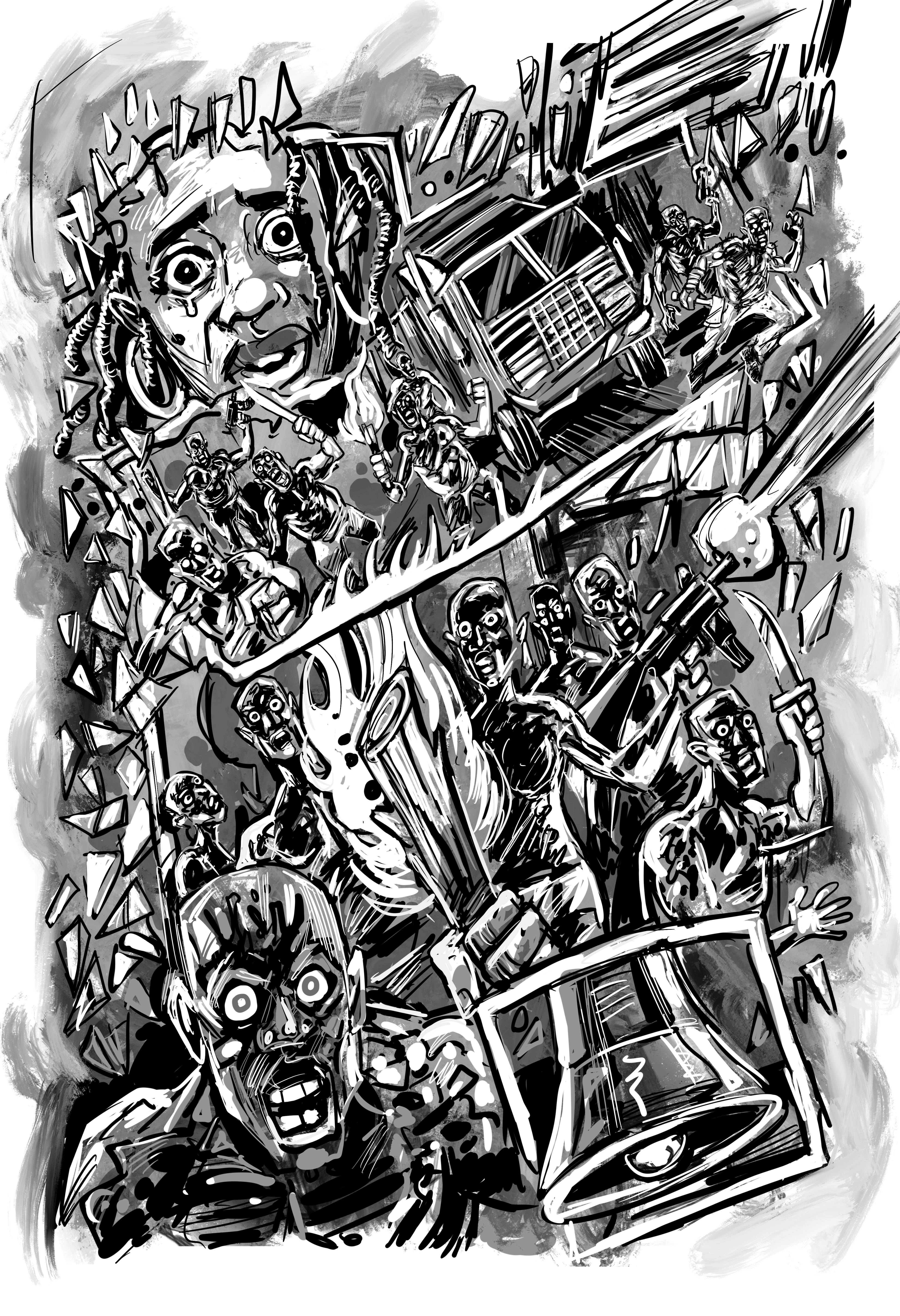
John Jennings’s work succeeds as sequential storytelling and approaches the level of iconography regularly. This page from the forthcoming graphic novel adaptation of Octavia Butler’s Parable of the Sower is a prime example of his acumen.
—Ayize Jama Everett
THE BELIEVER: When did you first “see” this page? Was it when you read the book? When you read Damian Duffy’s [his collaborator on Kindred and Parable] script page?
JOHN JENNINGS: I knew that the “Fall of Robledo” was a key aspect of the story, so it had to be dramatic. Damian brings a very cinematic style to his writing and that comes through here. I also knew that I didn’t have a lot of space to make an impact. The page had to be powerful, terrifying, and immediate.
BLVR: It is a pivotal moment in the book. Do you remember the first time reading it?
JJ: Yes. Because the story is being told in the first person via Lauren’s journal, it jumps around in time a lot. She is alluding to this happening but it still hits you in the gut when it [the Fall of Robledo] finally jumps off. You know it’s happening, but Octavia still manages to surprise us!

BLVR: Yeah, it’s kind of a legendary mic drop. I know that you sometimes work from rough sketches on paper that you scan and sometimes you go full digital. What was the process with this one?
JJ: Actually, I’ve gone fully digital. The iPad Pro with The Procreate app has changed everything about how I work. Kindred may be the last sequential work I do by hand. This book was totally done in the IPad, and it was great!
BLVR: Why do you find working digital better than the old school pen and Bristol board?
JJ: It’s fast and flexible. I can make changes very quickly. There’s no scanning and no cleanup of scans. I actually use two iPads. I work on one while the other is charging: sort of like how a photographer charges flashes. This book is almost 300 pages and it was totally drawn and colored in about eight months. No way that would have been possible with an analog process. Not without an injury. I know that from experience.
BLVR: So it’s physically taxing to get some of this stuff done. Let’s talk about the panel breakdown or lack thereof is on this page. How did you construct it?
JJ: After reading the script and taking notes, I first lay down an idea of the design or flow of the page. Then I sketched out the figures with the watercolor brush after the sketch is approved, I create a layer for the inks. Once the inks are done I go the sketch and smudge it to give it a texture. I add the highlights and then finish off the details. That’s another amazing thing with the iPad. You can zoom in and get very tight with details.
BLVR: You make it sound like the page can barely contain the detail you’re putting in.
JJ: You can zoom in super tight! Over 300%!

BLVR: Which do you recommend, digital format or traditional book bound version?
JJ: I think the actual book is best. I haven’t seen it yet. I’ve only seen the galleys of it but the printing is wonderful.
BLVR: One of the few criticisms that have been leveled at Octavia Butler is that she doesn’t do a lot of character description. How did you go about the character design of these characters?
JJ: I didn’t find her descriptions to obscure at all. Butler gives us enough cues for us to do a solid rendition of the characters. But there were a lot of characters, and it was hard to keep them straight. Also, it’s hard to design a character and then put them through the wringer, or even kill them. You become close to them once you’ve drawn them so much.
BLVR: How close is your rendition of Lauren to the vision of her you had when you first read the book?
JJ: It’s pretty close. I think I “toughened” her up a lot but I didn’t change her too much. my earlier sketches had her too young.
BLVR: I’m wondering about the fan response when you depict characters like Lauren and Dana from Kindred. Butler fans are wedded to their characters and you’re visualizing some of them for the first time. Have people come at you with, “That’s NOT how she’s supposed to look!”?
JJ: Oh yes. All the time. I think once we talk about the decisions though, that fans understand the method to the madness. You can’t get it totally right. We can do our best to honor the material. I’m sure so many people aren’t going to like what we do but we have to our best and move forward. That’s all you can do.
BLVR: The panel breakdowns are chaotic and studded with broken glass. Why that decision? What were you trying to get across?
JJ: it’s one of the most disruptive aspects of the book. All that Lauren knows is about to change. Even though she’s prepared for it and has been foretelling it, the actual event turns everyone and everything inside out. It needed to be explosive and destroy her entire world and that needed to be brutally evident. The structure of the pages had to be assaultive.
BLVR: It worked. And the colors? Who chose the palette?
JJ: Octavia Butler did when she set it in Southern California. The entire palette is based on swatches from photos that I took from the actual sky and mountains. Around Riverside, California. The color assistants were told to use those colors to do their flat colors and I did the rendering on the colors for storytelling.
BLVR: Can you explain that process a bit more?
JJ: Well, once the pages are inked digitally they were given to the flatting team. Flatters use Photoshop to do the flat, un-rendered colors on a layer. They then send me those pages, which I then bring into Procreate on my iPad and I then render the pages. I then send those to Damian for lettering.
BLVR: And by render you mean…
JJ: Adding the lights and darks to the images. Adding the effects and nuances of colors.
BLVR: In this pivotal scene you had work the images on the page about how many separate times?
JJ: Technically four. Because you have to sketch each page, ink each page, flat each page, and then render each page. It’s quite a lot of work.
BLVR: Stylistically, who would you say is your biggest influence when it comes to this book?
JJ: Denys Cowan and Phillippe Druillet. I hope I caught some of their brilliance in my pages. Steve Ditko is also a big influence as well.
BLVR: I see the Cowan, the rain-soaked, almost woodcut looking pages. His work on the Question is still a primer on what the page can do. Say more about Phillippe Druillet though. Where would the casual observer see his influence on this page in particular?
JJ: On the full pages with the fire? indeed. Druillet had a knack for using a lot of detail and almost flattening the space. It’s like he turned the entire page into an icon. It looked very much like etching or printmaking. I have a lot of that in my hand so to speak.

BLVR: I’m glad you said that, because the level of iconography in your work is ever-present. It competes favorably with the sequential storytelling aspect of your work. This page is a perfect example of that. It could be a hellish triptych or a page in a graphic novel.
JJ: Thank you.
BLVR: You’re a member of a growing number of artists who cross the lines from fine art to commercial art to academic. I wonder if anything is lost in those transitions. I’m thinking about those early comic book artists who worked like draftsman on pages. A lot of that artistry was missed but I’m wondering if there are any of those secret skills that you see from the Gil Kane’s, Wally woods, even Dave Mazzucchelli’s that you wish you had more time to study?
JJ: I think for me, I wished that I just had more time to practice and more access to resources. There was a time in my career where I just worked as a designer and gave up on making comics. I’d love to go back through time and talk to that John and tell him to find more time to work on pages. I’m not trained as a comic book artist. That does give me a certain kind of freedom but I also had to learn on the fly. As for those masters’ “secret skills”, I think those men were just forged in the fire of a monthly deadline and trying to feed themselves every month with their art. It becomes second nature once you’ve done so much. Practice makes perfect and there aren’t any short cuts




